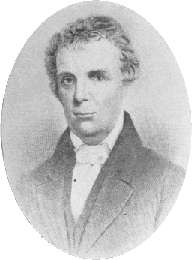Barton W. Stone
| This article includes a list of references, related reading or external links, but its sources remain unclear because it lacks inline citations. Please improve this article by introducing more precise citations where appropriate. (July 2010) |
Contents[hide] |
[edit] Early life and education
Stone was born to John and Mary Stone in Port Tobacco, Maryland. During his childhood, the boy grew up within the Church of England, then had Baptist, Methodist and Episcopal church influences as well. Preachers representing Baptists and Methodists came to the area during the Second Great Awakening, and Baptist and Methodist chapels were founded in the county.After going to Guilford Academy in North Carolina, founded by David Caldwell [1], Stone heard James McGready (a Presbyterian minister) speak. He studied and became a Presbyterian minister. But, as Stone looked more deeply into the beliefs of the Presbyterians, especially the Westminster Confession of Faith, he doubted that some of the church beliefs were truly Bible-based. In particular, he found the Calvinistic insistence on man's total depravity to be inconsistent with the Scriptures.
[edit] Career
Stone also took issue with the doctrine of the Trinity, and argued against it. "Revelation no where declares that there are three persons of the same substance in the one only God; and it is universally acknowledged to be above reason" (Address to the Christian Churches, 2nd Edition [1821]). At the Cane Ridge, Kentucky revival of 1801, which attracted an estimated 20,000 people, Stone revealed his new-found conviction of faith as the only prerequisite for salvation. This was not in keeping with the doctrines of the Presbyterian Church, which accused Stone of Arminianism. Although he left the Kentucky Synod of the Presbyterian Church, he continued to work to bring people to Christ.[citation needed]| Wikisource has original text related to this article: |
In 1824 in Kentucky, Stone met with Alexander Campbell, a meeting that led to the partial unification of the "Christian" (Stone) movement and the "Reformed Baptist" (Campbell) movement into what is commonly called the Restoration Movement. Campbell had been working in Pennsylvania, Ohio and Virginia, mostly among Baptist groups. Stone had been preaching to Presbyterians in Kentucky and Ohio, although trying to lead them from "denominational bondage". Campbell had been publishing the Christian Baptist and Stone the Christian Messenger, starting in 1826. Through these publications, they began to bring their followers closer together in uniting under Christ.[1] This movement was especially powerful among the churches in the backcountry and on the western frontier.
Congregations that were part of Stone's original movement but chose not to join with Campbell and his followers, merged with similar Christian Churches in other parts of the country. They formed the Christian Connection.[citation needed]
Stone died on November 9, 1844 in Hannibal, Missouri at the home of his daughter. His body was buried on his farm in Morgan County, Illinois. When the farm was sold, descendants had his remains reinterred at Antioch Christian Church east of Jacksonville. In 1847 his remains were moved again and reinterred at Cane Ridge, Kentucky.
A marble shaft there is inscribed:
"The church of Christ at Cane Ridge and other generous friends in Kentucky have caused this monument to be erected as a tribute of affection and gratitude to Barton W. Stone, minister of the gospel of Christ and the distinguished reformer of the nineteenth century. Born December 24, 1772: died November 9, 1844. His remains lie here. This monument erected in 1847."[1]
[edit] Legacy and honors
- 1847 - A monument was erected in Stone's honor at his gravesite in Cane Ridge, Kentucky
- Barton College (formerly Atlantic Christian College) in Wilson, North Carolina was named in his honor.
[edit] Citations
[edit] External links
- Barton Warren Stone's memorial at findagrave.com
- Writings of Barton W. Stone, Memorial University, Canada
[edit] References
- West, Earl Irvin (2002). The Search for the Ancient Order, Vol. 1. Gospel Light Publishing Company. ISBN 0-89225-154-9
- Foster, Douglas A.(Editor), Blowers, Paul M.(Editor), Dunnavant, Anthony L.(Editor), Williams, D. Newell(Editor). The Encyclopedia of the Stone-Campbell Movement. Wm. B. Eerdmans Publishing Company, Grand Rapids, Michigan. ISBN 0-8028-3898-7
- John Rogers, THE BIOGRAPHY OF ELD. BARTON W. STONE, WRITTEN BY HIMSELF: WITH ADDITIONS AND REFLECTIONS, (Cincinnati: J.A. & U.P. James, 1847), 120-29, at Dr. Hans Rollman, Restoration Movement Website, Memorial University of Newfoundland
| |||||||||||||||||||||||||||||||


